Zenair CH 200
The Zenair Zenith CH 200 and CH 250 are a family of Canadian single-engined homebuilt light aircraft. It is a low-winged single engine monoplane, that was first flown in France in 1970, with kits being made by the Canadian company Zenair from 1974, with hundreds built and flown.
| Zenith CH 200 & 250 | |
|---|---|
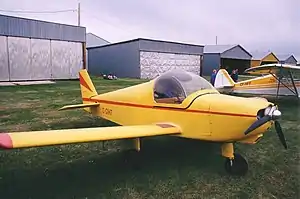 | |
| CH 200 | |
| Role | Homebuilt light aircraft |
| National origin | France/Canada |
| Manufacturer | Zenair |
| Designer | Chris Heintz |
| First flight | 22 March 1970 |
Development and design
In October 1968, the French aeronautical engineer Chris Heintz, who worked for Avions Pierre Robin, started work on the design of a two-seat all-metal light aircraft suitable for amateur construction, the Zenith, with the prototype making its maiden flight on 22 March 1970.[1]
Heintz migrated to Canada in 1973,[2] and set up Zenair in 1974 to sell plans and kits of the Zénith.[3] The Zenith, which gained the designation Zenith CH 200 when Heintz produced plans for larger and smaller derivatives, is a low-winged cantilever monoplane of all metal construction. The pilot and passenger sit side by side under a clear, sideways-opening plexiglas canopy, while the aircraft is fitted with a fixed nosewheel undercarriage. It is designed to be powered by a single piston engine of between 85 and 160 hp (63.5 and 119 kW).[4]
The first Zenith to be built in North America flew in October 1975, and by 1976, over 300 plans had been sold.[5] Plans continued to be available in 1999, by which time hundreds were flying.[6]
At the 1976 EAA Convention in Oshkosh, Wisconsin the factory used volunteer labour to build and fly a CH 200 in eight days, using 550 person-hours.[7]
Variants
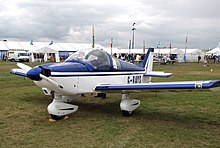
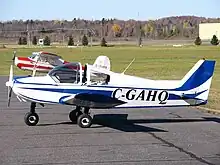
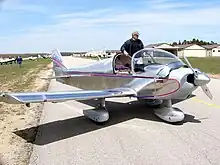
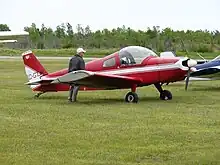
- Zenair CH 200
- Initial version. Could be built as a cross country cruiser with an engine of 85 to 125 hp (63 to 93 kW) or as an aerobatic trainer with modifications and a powerplant producing 125 to 160 hp (93 to 119 kW). The aircraft can be constructed as a taildragger or on tricycle gear and flown as a skiplane or on floats.[7]
- Zenair CH 250
- Improved version with more fuel, larger baggage area, rear windows and a forward sliding canopy.[4][7]
- Zenair CH 250 TD
- "Tail Dragger" version with conventional landing gear.[7]
Specifications (100 hp engine)
Data from Jane's All The World's Aircraft 1982-83[4]
General characteristics
- Crew: 2
- Length: 20 ft 6 in (6.25 m)
- Wingspan: 23 ft 0 in (7.00 m)
- Height: 6 ft 11 in (2.11 m)
- Wing area: 105.5 sq ft (9.80 m2)
- Aspect ratio: 5:1
- Airfoil: NACA 64A515 (Modified)
- Empty weight: 900 lb (408 kg)
- Max takeoff weight: 1,450 lb (658 kg)
- Fuel capacity: 16 Imp Gallons (72.5 L)
- Powerplant: 1 × Continental O-200 air-cooled flat-four, 100 hp (75 kW) (suitable for engines of between 85 hp (63.5 kW) and 160 hp (119 kW))
Performance
- Maximum speed: 147 mph (237 km/h, 128 kn) at sea level
- Cruise speed: 130 mph (210 km/h, 110 kn) (75% power) at sea level
- Stall speed: 53 mph (85 km/h, 46 kn) (flaps down)
- Range: 520 mi (840 km, 450 nmi)
- Service ceiling: 15,100 ft (4,600 m)
- Rate of climb: 800 ft/min (4.1 m/s)
Notes
- Taylor 1976, p. 457.
- Chris Heintz:Designer". Zenith Aircraft Company. Retrieved 27 February 2010.
- Gunston 2005, p.525.
- Taylor 1982, p.494.
- Taylor 1976, p.458.
- Taylor 1999, p.535.
- Zenair, Zenair pamphlet, circa 1986.
References
- Gunston, Bill. World Encyclopedia of Aircraft Manufacturers. Second edition. Stroud, UK:Sutton Publishing, 2005. ISBN 0-7509-3981-8.
- Taylor, John W. R. Jane's All The World's Aircraft 1976-77. London:Jane's Yearbooks, 1976. ISBN 0-354-00538-3.
- Taylor, John W. R. Jane's All The World's Aircraft 1982-83. London:Jane's Yearbooks, 1982. ISBN 0-7106-0748-2.
- Taylor, Michael J. H. Brassey's World Aircraft & Systems Directory 1999/2000. London:Brassey's, 1999. ISBN 1-85753-245-7.